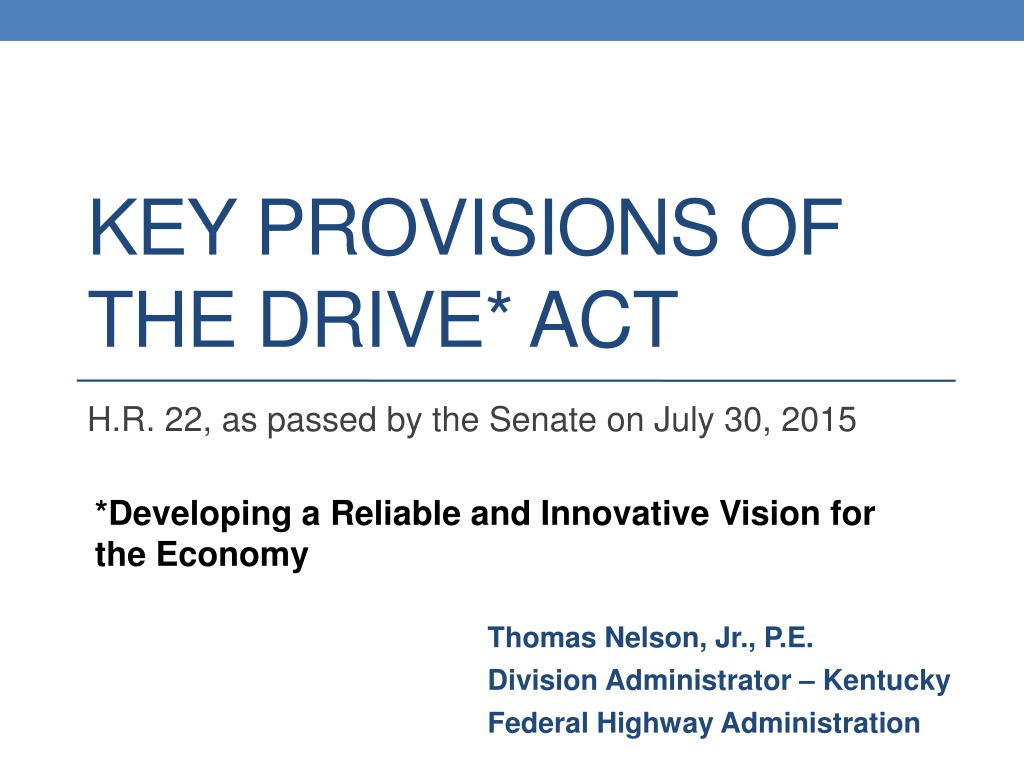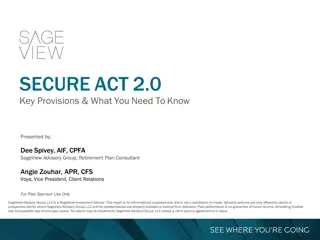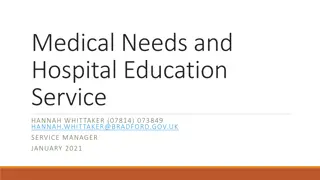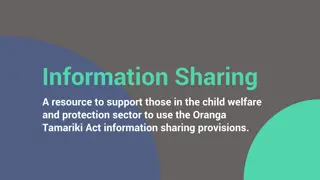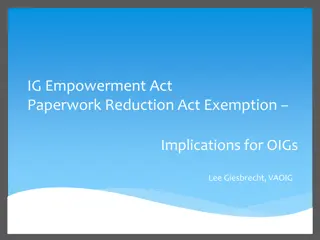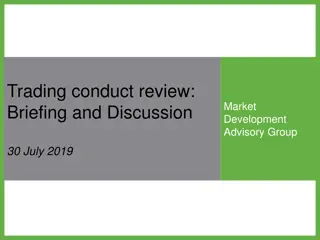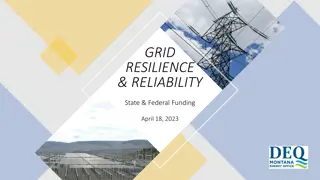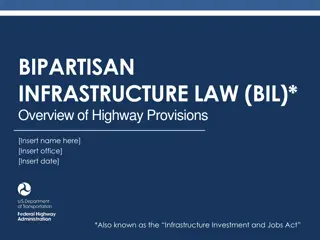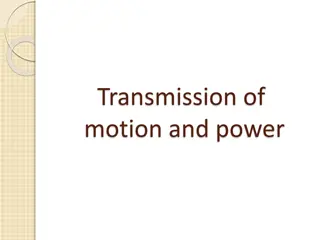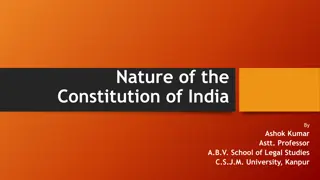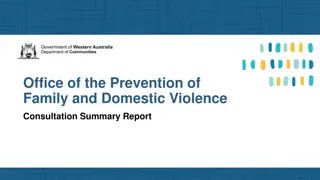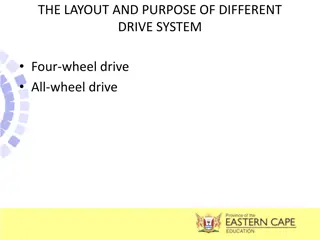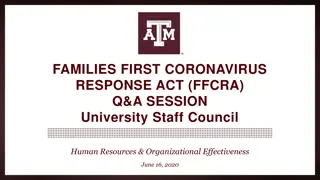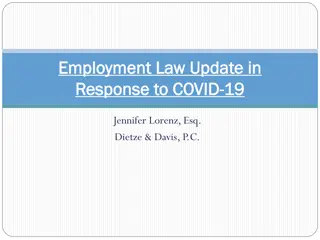Key Provisions of DRIVE Act H.R. 22 - Summary and Highlights
The DRIVE Act H.R. 22, passed by the Senate in 2015, aims to provide long-term funding certainty for highway projects, increase funding for existing programs, and introduce new initiatives to enhance project delivery efficiency and transparency. With a total highway funding of $276.6 billion over a 6-year period, the act focuses on supporting multi-year investments, improving freight transportation, and prioritizing major infrastructure projects.
Download Presentation

Please find below an Image/Link to download the presentation.
The content on the website is provided AS IS for your information and personal use only. It may not be sold, licensed, or shared on other websites without obtaining consent from the author. Download presentation by click this link. If you encounter any issues during the download, it is possible that the publisher has removed the file from their server.
E N D
Presentation Transcript
KEY PROVISIONS OF THE DRIVE* ACT H.R. 22, as passed by the Senate on July 30, 2015 *Developing a Reliable and Innovative Vision for the Economy Thomas Nelson, Jr., P.E. Division Administrator Kentucky Federal Highway Administration
2 Key Highway Facts 6-year surface transportation reauthorization proposal covering FYs 2016-2021 with 3 years paid for Total highway funding $276.6 billion Contract authority - $274.0 billion Subject to appropriation - $2.6 billion 5 new programs Continued focus on accelerating project delivery
3 DRIVE Act Themes - Highway Long-term funding certainty to support multi-year project investments Increased funding for existing programs to provide a strong Federal partner to State & local governments New freight program to help state deliver projects that more freight safely, efficiently, and reliably Targeted funds for major projects Greater efficiency in the project delivery process Increased priority for the Interstate, NHS and bridges Greater transparency to reinforce public trust Support for innovative finance tools, particularly in rural areas
4 Increased funding, but less than GROW Average Annual Highway Authorizations (billions) 60 12.1% higher than FY 2015 50 40 30 $46.1B $41.1 B $52.8 B 20 10 0 FY 2015 GROW AMERICA Act DRIVE Act
5 Growth varies by program Program DRIVE Act Growth over FY 2015 +10.2% +6.8% +7.9% -8.4% +0% +13.2 +100% (new) +100% (new) -70.0% +8.9% +5.8% +5.0% National Highway Performance Program Surface Transportation Program Congestion Mitigation & Air Quality Improvement Prog. Highway Safety Improvement Program Railway-Highway Crossings Program Metropolitan Planning National Freight Program Assistance to Major Projects Program TIFIA Tribal Transportation Program Federal Lands Transportation Program Federal Lands Access Program
6 92.6% of highway funds are apportioned NEW Grade Crossings Freight CMAQ Transportation Alternatives HSIP Surface Transportation Program National Highway Performance Program $256.2 billion over 6 years Metro Planning
7 NEW PROGRAMS
8 Freight Policy and Grants Combining the provisions from the EPW and Commerce Committees produced overlapping freight policies and programs Designation of National Multimodal Freight Network and a National Highway Freight Network A highway-centric National Highway Freight Program and a more comprehensive competitive grant program providing assistance to freight projects
9 National Highway Freight Program Purpose: to improve the efficient movement of freight on the National Highway Freight Network made up of Primary highway freight system (PHFS) (up to 30,000 miles) Critical rural freight corridors Critical urban freight corridors NEW Any remaining Interstate routes (including future routes designated as of enactment) Average of $1.9 billion per year apportioned based on States total apportionments. Highway focused - Maximum of 10% of State s freight funds may be used for public or private freight rail, water facilities (including ports) and intermodal facilities
10 National Highway Freight Program Freight plan and performance State must have a State freight plan within 2 years to continue participation in the Freight Program. State freight advisory committee is also required. State must develop a freight performance improvement plan if not making significant progress within 2 years of setting performance targets. Redesignation of the Highway Freight Network will still be challenging. Requires redesignation of the PHFS 1 year after enactment and every 5 years there after without regard to connectivity of PHFS States/MPOs may add both rural and urban corridors to the National Freight Network
11 Assistance for Major Projects Program Average of $350 million per year from HTF aimed at critical, high-cost nationally and regionally beneficial projects. States, locals, tribes, transit agencies, public authorities and FLMAs (in conjunction with State) eligible to apply. Capital projects that are eligible for financial assistance under title 23 or chapter 53 of title 49 Generally for projects over $350 million with minimum grant of $50 million, but reduced thresholds for rural states, Federal lands projects.
12 Regional Infrastructure Accelerator Demo To assist entities in develop improved infrastructure priorities and financing strategies for accelerated development of TIFIA-eligible projects. DOT to establish regional accelerators to Evaluate and promote innovative financing methods for local projects, including TIFIA Build capacity of State, local, tribal governments to evaluate & structure projects Bundle small scale and rural projects to make them more attractive for investment. Reduce transaction costs for public sponsors $12 million from General Fund over 6 years to fund Demo
13 OTHER PROVISIONS
14 Every Day Counts Codifies FHWA s successful innovation initiative, Every Day Counts FHWA Administrator to work with States, local transportation agencies, and industry stakeholders to identify and deploy proven innovations that Accelerate innovation deployment Shorten the project delivery process Improve environmental sustainability Enhance roadway safety Reduce congestion FHWA to collaborate to identify new innovations for deployment at least every 2 years.
15 Tolling & HOV ISRRP Streamlines the application process and sets standards to reduce the time that a slot can be held without progress HOV Timeline for addressing HOV facilities with degraded performance Toll credits pilot allowing States with toll credits to sell them to other States to be used in lieu of match
16 Other Provisions Bundling bridge projects specifically allowing multiple bridge projects to be handled as a single project. Responsibility for bridge closure or load restrictions adopts the GROW AMERICA Act proposal State flexibility for NHS modifications National electric vehicle charging and natural gas corridors to be designated
17 Highway Trust Fund Extends highway taxes at current rates through FY 2023 (heavy vehicle use tax through FY 2024) Extends expenditure authority through FY 2021 There are solvency provisions Revenue supplements and offsets in the bill cover FYs 2016-2018. To prevent shortfalls in the outyears--
18 THANK YOU! Thomas Nelson, Jr., P.E. Division Administrator - Kentucky Federal Highway Administration Thomas.Nelson@dot.gov 502-223-6721
